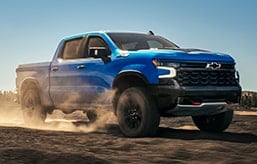- This AAA and University of North Carolina study examined the effectiveness of advanced driver assistance systems (ADAS) and projected expectations over a 30-year span, from 2021 to 2050.
- The report estimates 27 million crashes could be avoided because of these driver aids.
- The study also estimated 250,000 lives would be saved by safety systems such as forward collision warning, automatic emergency braking and adaptive cruise control.
- Significant hurdles remain in consumer acceptance and understanding, however. And some safety aids have been found to have major limitations during AAA-conducted crash simulations.
AAA Study Finds Advanced Driver Assistance Systems Could Prevent 250,000 Deaths
The AAA study found advanced driver aids could prevent 27 million crashes by 2050
Hundreds of thousands of lives could be saved and tens of millions of crashes prevented thanks to advanced driver assistance systems (ADAS) such as automatic emergency braking, adaptive cruise control and forward collision warning. That’s according to a recent study conducted by the American Automobile Association (AAA) Foundation for Traffic Safety and the University of North Carolina.
The potential benefits of these driver aids appear staggeringly effective based on projected figures alone. According to the report, current ADAS technologies could prevent approximately 14 million injuries and 37 million crashes over a 30 year span, stretching from 2021 to 2050.
In addition, the report estimates ADAS would prevent approximately 250,000 deaths over the next 30 years. In total, the AAA study states this represents 16% of injury crashes and 22% of all deaths that would occur on U.S. roads without these technologies during this same 30-year span.
“The findings from this latest study on the AAA Foundation’s work in emerging technologies suggest that ADAS has the potential to transform road safety,” said Dr. David Yang, president and executive director of the AAA Foundation. The specific automotive safety technologies that were taken into consideration include automatic emergency braking, forward collision warning, pedestrian detection, adaptive cruise control, lane departure warning and lane keeping assistance.
These are all active driver aids, meaning they take over some degree of steering or braking input when activated. As one of its baselines for prediction, the study also assumed the number of future crashes will be similar to crash levels from 2017 to 2019 and then factored annual increases due to increasing vehicle travel.
While ADAS undoubtedly helps prevent, or at least lessen, the severity of an accident in many situations, there are serious hurdles when it comes to consumer acceptance and understanding of these systems. Via emailed responses to an Edmunds enquiry regarding the study, AAA Northeast's Robert Sinclair expanded upon these challenges.
“There is a steep learning curve in understanding the technologies and what they can and cannot do. Ultimately, it’s up to the vehicle owner to learn how they work, but the dealership should do all they can to help drivers master the workings of ADAS,” he stated.
Sinclair also noted something as seemingly innocuous as the name of a driver aid can lead to confusion. “Some of the marketing-driven names of the technologies can mislead drivers into thinking that autonomous driving is possible. This is not the case, and AAA has urged manufacturers to come up with some standardization of nomenclature and operation of the technology for improved public understanding.”
While Sinclair did not single out a specific mislabeled safety system, one example of safety tech that’s created controversy along these lines is Tesla’s Autopilot driving aid. Critics have argued that being labeled “autopilot” suggests the system is hands-free and capable of operating in all driving situations without any human intervention.
“None of the ADAS technologies are 100 percent effective, but they do help a driver in a host of situations,” added Sinclair. There is work to be done in terms of technological refinement, however. He pointed to two AAA studies, where current driver aids proved surprisingly ineffective in preventing accidents. “Probably the most deficient is the pedestrian detection system at night when the cameras are not able to 'see' pedestrians due to low light.”
In a AAA study conducted in 2019 regarding the effectiveness of automatic emergency braking systems with pedestrian detection, the findings discovered the degree of accident prevention was woefully inadequate. The testing was done on a closed course using simulated pedestrian targets and with four midsize sedans. In one test, a collision occurred 89% of the time in a scenario where a "child" dashing out from between two parked cars moved in front of a vehicle traveling at 20 mph. Worse still, during night-time tests, pedestrian detection had a 100% failure rate — none of the vehicles reacted to simulated adult pedestrians.
AAA also recently found similar deficiencies in the effectiveness of automatic emergency braking (AEB) at higher speeds. Four 2022 model year vehicles were used for testing purposes: a Chevrolet Equinox LT with Chevy Safety Assist, a Ford Explorer XLT with Pre-Collision Assist with Automatic Emergency Braking, a Honda CR-V Touring with Honda Sensing, and a Toyota RAV4 LE with Toyota Safety Sense.
At speeds of 30 mph, these AEB-equipped vehicles avoided a rear-end collision with a stationary vehicle/obstacle in 17 of 20 tests. That’s impressive, and even the three "failures" had a silver lining since their impact speed was reduced by 86% on average.
But when testing speed was nudged to 40 mph, the AAA found AEB prevented a crash in only six of 20 test runs. The average impact speed in the 14 failures was at least reduced by 62%. Unfortunately, the findings worsened during tests that used simulated target vehicles, such as T-bone collisions and left turns in front of oncoming vehicles. The failure rate was again 100%.
“The full safety benefits of ADAS will not be realized unless they are fully understood by the consumer, operate properly and are widely adopted,” explained Sinclair. “While ADAS will save hundreds of thousands of lives over the course of time, regrettably, many will still die in crashes. Bad drivers will still drink and drive, run red lights, speed and not wear seat belts. While ADAS is helpful at preventing crashes, there is no substitute for a well-trained, responsible, sober driver for preventing crashes and saving lives.”
Edmunds says
Creating safer roads is about more than adding more and more active driving aids onto new vehicles. Consumer education and refinement of the systems themselves are vitally important. Even so, the AAA study notes that, imperfect as some drivers and safety tech might be, ADAS has the potential to save thousands of lives and prevent millions of accidents.



 by
by